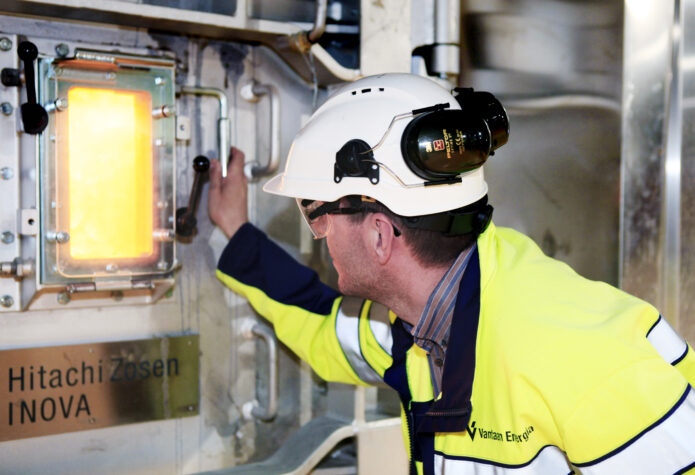Vantaa: Converting garbage into energy and heat

In the easternmost corner of Vantaa, a brand-new, state-of-art waste plant dominates the skyline. Financed with a loan from NIB, the facility is designed to burn mixed waste from 1.5 million residents of the Helsinki Metropolitan Area. It is surprisingly calm, clean and odourless, both inside and outside. But much must be cooking, as the plant’s two enormous boilers burn 11 kilos of waste every second, around the clock.
Every day, about 200 trucks will arrive, loaded with empty coffee packages, rubbish bags and nappies—and whatever else finds it ways into household mixed waste. The largest and most energy-efficient waste-to-energy plant in Finland converts them via combustion into district heat and electricity. The figures are impressive: 920 gigawatt-hours (GWh) of district heat and 600 GWH of electricity every year.
“These production volumes correspond to about half of Vantaa’s district heat requirement and about 30% of the city’s electricity annual need”, says Kalle Patomeri, project manager at Vantaa Energy, an energy company jointly owned by two cities—Vantaa and Helsinki.
The plant can heat some 100,000 two-room apartments and help decrease the region’s CO2 emissions substantially. According to Mr Patomeri, the plant can utilise 95 per cent of the energy in the fuel waste, making the facility almost carbon-neutral. And the cleanliness of those few emissions released, mainly flue gas, is carefully monitored.
“The amounts of emissions that this plant produces are only 10 per cent of the volumes allowed by the environmental permit”, Mr Patomeri explains.
“For me personally, it was extremely important that this plant is also odourless inside, so I can go home at the end of the day in clothes that don’t stink,” says Mr Patomeri laughing.
He designed the plant’s ventilation and utilised the experience he gained at a similar plant in Kotka in eastern Finland. His work makes the Vantaa plant Europe’s least odorous waste-to-energy facility. Waste specialists from all over Europe have visited Vantaa to benchmark the plant’s innovative construction solutions.
In addition to the cleaner air, the results for an ordinary Vantaa citizen are also visible in their district heat bills.
“Last year, Vantaa was among very few municipalities that actually lowered the price of district heating. Therefore, this can be considered a win-win project, both environmentally and economically”, states Mr Palomeri proudly.
The plant reduces the Helsinki region’s dependence on imported fossil fuels, such as coal and natural gas, and also has a large impact on regional waste management. The plant’s fuel—mixed waste from an area of southern Finland ranging from Hanko in the west to Porvoo in the east—is no longer transported to pile up in the already crammed waste handling facility in neighbouring Espoo. As a result, less methane from decomposition is released into the air.
Future focus is on prevention and recycling
The roots of the Vantaa’s new plant can be traced to the renewed EU waste legislation intended to drastically change waste management practices in Europe. Now, the foremost aim should be to prevent waste from occurring in the first place, and existing waste ought to be recycled or biologically treated. Non-recyclable items should be utilised as energy, with only the minimum of waste allowed to be transported to landfill.
“Although the current emphasis is on prevention, unfortunately we are not expecting any significant reductions in the next ten years. For us here, the fuel keeps coming, and actually there has been more of it than we first thought. However, I am optimistic that slowly people will learn to reduce the amount of waste they generate. What I would really love to see right away, though, is people paying more attention to recycling”, says Mr Patomeri.
Outside the plant are two large waste troughs filled with metal waste received in recent weeks—waste the plant cannot utilise. These rusty items illustrate how little some people care about sorting their waste, as metal, glass bottles and glass jars do not belong in mixed waste.
“Small metal items we can handle, but large items, like the metal bathtub that was brought here last week, interrupt the combustion process. That naturally has an economic effect every time”, Mr Patomeri explains.
According to Mr Patomeri, the scale of things people throw away is almost bewildering. So many almost-new and still-functioning items end up in rubbish bags that one can only guess the value of so-called “waste”. When looking at the piles discarded items inside the plant’s waste bunker, it is not difficult to spot perfectly usable goods like toys, decorative items or clothing.
“For some reason, Finnish people are lazy about recycling compared to the neighbouring countries. There’s room to develop education in that sector, and we should be focusing on costs and the environment. It is, after all, the municipalities that carry the burden of taking care of incorrectly discarded waste—and that has a cost impact for citizens”, says Mr Patomeri.
At least from now on in Vantaa, those leftover items have a purpose as a fuel.
NIB provided EUR 150 million in financing for the construction of Vantaa’s waste-to-energy plant.

